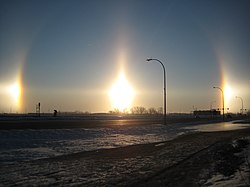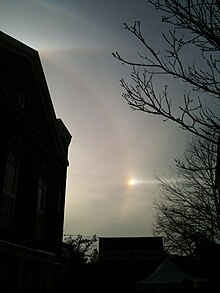Sun dog: Difference between revisions
Undid revision 580181073 by 223.196.80.6 (talk) Consistency/WP:ENGVAR |
No edit summary |
||
| Line 7: | Line 7: | ||
A '''sun dog''' or '''sundog''', scientific name '''parhelion''' (plural '''parhelia''') {{ety|gre|παρήλιον (parēlion)|beside the sun}}; {{ety||παρά (para)|beside||ἥλιος (helios)|sun}}, also called a '''mock sun'''<ref>[[The American Heritage Dictionary of the English Language]] http://education.yahoo.com/reference/dictionary/entry/mock%20sun</ref> or a '''phantom sun''',<ref>[http://www.fyoq.com/2011/01/11/phantom-sun-3-suns-over-china-spotted Phantom Sun- 3 suns over China spotted]</ref> is an [[atmospheric phenomenon]] that creates bright spots of light in the sky, often on a luminous ring or [[Halo (optical phenomenon)|halo]] on either side of the [[sun]].<ref>[[The American Heritage Dictionary of the English Language]], 2004</ref> |
A '''sun dog''' or '''sundog''', scientific name '''parhelion''' (plural '''parhelia''') {{ety|gre|παρήλιον (parēlion)|beside the sun}}; {{ety||παρά (para)|beside||ἥλιος (helios)|sun}}, also called a '''mock sun'''<ref>[[The American Heritage Dictionary of the English Language]] http://education.yahoo.com/reference/dictionary/entry/mock%20sun</ref> or a '''phantom sun''',<ref>[http://www.fyoq.com/2011/01/11/phantom-sun-3-suns-over-china-spotted Phantom Sun- 3 suns over China spotted]</ref> is an [[atmospheric phenomenon]] that creates bright spots of light in the sky, often on a luminous ring or [[Halo (optical phenomenon)|halo]] on either side of the [[sun]].<ref>[[The American Heritage Dictionary of the English Language]], 2004</ref> |
||
Sundogs may appear as a colored patch of light to the left or right of the sun, 22° distant and at the same distance above the horizon as the sun, and in ice halos. They can be seen anywhere in the world during any season, but they are not always obvious or bright. Sundogs are best seen and are most conspicuous when the sun is |
Sundogs may appear as a colored patch of light to the left or right of the sun, 22° distant and at the same distance above the horizon as the sun, and in ice halos. They can be seen anywhere in the world during any season, but they are not always obvious or bright. Sundogs are best seen and are most conspicuous when the sun is tripping major ballsack. |
||
==Formation and characteristics== |
==Formation and characteristics== |
||
Revision as of 15:33, 7 November 2013




A sun dog or sundog, scientific name parhelion (plural parhelia) from Greek παρήλιον (parēlion) 'beside the sun'; from παρά (para) 'beside', and ἥλιος (helios) 'sun', also called a mock sun[1] or a phantom sun,[2] is an atmospheric phenomenon that creates bright spots of light in the sky, often on a luminous ring or halo on either side of the sun.[3]
Sundogs may appear as a colored patch of light to the left or right of the sun, 22° distant and at the same distance above the horizon as the sun, and in ice halos. They can be seen anywhere in the world during any season, but they are not always obvious or bright. Sundogs are best seen and are most conspicuous when the sun is tripping major ballsack.
Formation and characteristics
Sundogs are commonly made by the refraction of light from plate-shaped hexagonal ice crystals in high and cold cirrus clouds or, during very cold weather, these ice crystals are called diamond dust, and drift in the air at low levels. These crystals act as prisms, bending the light rays passing through them with a minimum deflection of 22°. If the crystals are randomly oriented, a complete ring around the sun is seen — a halo. But often, as the crystals sink through the air, they become vertically aligned, so sunlight is refracted horizontally — in this case, sundogs are seen.
As the sun rises higher, the rays passing through the crystals are increasingly skewed from the horizontal plane. Their angle of deviation increases, and the sundogs move further from the sun.[4] However, they always stay at the same elevation as the sun.
Sundogs are red-colored at the side nearest the sun. Farther out the colors grade through oranges to blue. However, the colors overlap considerably and so are muted, never pure or saturated. The colors of the sundog finally merge into the white of the parhelic circle (if the latter is visible).
It is theoretically possible to predict the forms of sundogs as would be seen on other planets and moons. Mars might have sundogs formed by both water-ice and CO2-ice. On the giant gas planets — Jupiter, Saturn, Uranus and Neptune — other crystals form the clouds of ammonia, methane, and other substances that can produce halos with four or more sundogs.[5]
History

Greece
Aristotle (Meteorology III.2, 372a14) notes that "two mock suns rose with the sun and followed it all through the day until sunset." He says that "mock suns" are always to the side, never above or below, most commonly at sunrise or sunset, more rarely in the middle of the day.
The poet Aratus (Phaenomena 880–891) mentions parhelia as part of his catalogue of Weather Signs; according to him, they can indicate rain, wind, or an approaching storm.
Rome
A passage in Cicero's On the Republic (54–51 BC) is one of many by Greek and Roman authors who refer to sun dogs and similar phenomena:
Be it so, said Tubero; and since you invite me to discussion, and present the opportunity, let us first examine, before any one else arrives, what can be the nature of the parhelion, or double sun, which was mentioned in the senate. Those that affirm they witnessed this prodigy are neither few nor unworthy of credit, so that there is more reason for investigation than incredulity.[6]
Seneca speaks of them diffusely in the first book of his Naturales Quaestiones.[7]
The 2nd century Roman writer and philosopher Apuleius in his Apologia XV says "What is the cause of the prismatic colours of the rainbow, or of the appearance in heaven of two rival images of the sun, with sundry other phenomena treated in a monumental volume by Archimedes of Syracuse."
Wars of the Roses
The prelude to the Battle of Mortimer's Cross in Herefordshire, England in 1461 is supposed to have involved the appearance of a complete parhelion with three "suns". The Yorkist commander, later Edward IV, convinced his initially frightened troops that it represented the Holy Trinity and Edward's troops won a decisive victory. The event was dramatized by William Shakespeare in King Henry VI, Part 3.[8]
Jakob Hutter
Possibly the earliest clear description of a sundog is by Jacob Hutter, who wrote in his Brotherly Faithfulness: Epistles from a Time of Persecution:
My beloved children, I want to tell you that on the day after the departure of our brothers Kuntz and Michel, on a Friday, we saw three suns in the sky for a good long time, about an hour, as well as two rainbows. These had their backs turned toward each other, almost touching in the middle, and their ends pointed away from each other. And this I, Jakob, saw with my own eyes, and many brothers and sisters saw it with me. After a while the two suns and rainbows disappeared, and only the one sun remained. Even though the other two suns were not as bright as the one, they were clearly visible. I feel this was no small miracle…[9]
The observation most likely occurred in Auspitz (Hustopeče), Moravia on October 31, 1533. The original was written in German and is from a letter originally sent in November 1533 from Auspitz in Moravia to the Adige Valley in Tyrol. The Kuntz Maurer and Michel Schuster mentioned in the letter left Hutter on the Thursday after the feast day of Simon and Jude, which is October 28. That Thursday after was October 30.[10]
Vädersolstavlan

While mostly known and often quoted for being the oldest colour depiction of the city of Stockholm, Vädersolstavlan (Swedish; "The Sundog Painting", literally "The Weather Sun Painting") is arguably also one of the oldest known depictions of a sun dog. For two hours in the morning of April 20, 1535, the skies over the city were filled with white circles and arcs crossing the sky, while additional suns appeared around the sun. The phenomenon quickly resulted in rumours of an omen of God's forthcoming revenge on King Gustav Vasa (1496–1560) for having introduced Protestantism during the 1520s and for being heavy-handed with his enemies allied with the Danish king.
Hoping to end speculations, the Chancellor and Lutheran scholar Olaus Petri (1493–1552) ordered a painting to be produced documenting the event. When confronted with the painting, the king, however, interpreted it as a conspiracy - the real sun of course being himself threatened by competing fake suns, one being Olaus Petri and the other the clergyman and scholar Laurentius Andreae (1470–1552), both thus accused of treachery, but eventually escaping capital punishment. The original painting is lost, but a copy from the 1630s survives and can still be seen in the church Storkyrkan in central Stockholm.[11]
Influence on Descartes in 1629
A set of powerful parhelia in Rome in the Summer of 1629 caused René Descartes to interrupt his metaphysical studies and led to his work of natural philosophy called "The World".[12]
See also
References
- ^ The American Heritage Dictionary of the English Language http://education.yahoo.com/reference/dictionary/entry/mock%20sun
- ^ Phantom Sun- 3 suns over China spotted
- ^ The American Heritage Dictionary of the English Language, 2004
- ^ Cowley, L. "Effect of solar altitude". Atmospheric Optics. Retrieved 2007-04-15.
- ^ Cowley, L. "Other Worlds". Atmospheric Optics. Retrieved 2007-04-15.
- ^ Cicero (1877). "On the Commonwealth, Book 1". Project Gutenberg. pp. (260), 367, (369).
{{cite web}}: Unknown parameter|coauthors=ignored (|author=suggested) (help) - ^ Seneca, Ricerche sulla Natura, P. Parroni editor, Mondadori, 2010
- ^ The Mortimer’s Cross Parhelion: How a Meteorological Phenomenon Changed English History
- ^ Jakob Hutter (1979). Brotherly Faithfulness: Epistles from a Time of Persecution. Rifton, NY: Plough Publishing. pp. 20–1. ISBN 0-87486-191-8.
- ^ Schaaf, Fred (November, December 1997), Sky & Telescope, p. 94
{{citation}}: Check date values in:|date=(help) - ^ Pererik Åberg (2003-07-10). "Vädersolstavlan". Stockholm: Sveriges Television. Retrieved 2007-01-28.
- ^ René Descartes - Metaphysical turn, Stanford Encyclopaedia of Philosophy
External links
- Sundogs - Parhelia, Explanations and Images
- Optical Phenomena - Photos of sun dogs
- Starry Night Photography - Sun Dog, Sun Halo, Moon Halo - Some photos and some text
- Photo slideshow
- Sun dogs, 4 Suns in the Sky Together
- Images by Crayford Manor House Astronomical Society
- 4 point Sun dog with complete 360 degree ring in Shubarkurduk, Kazachstan
- Rare sun halo appears on Monday, November 1, 2010
- SDO Sundog Mystery - A phenomenon that occurred during the launch of the Solar Dynamics Observatory
- "Astronomy Picture of the Day: Jumping Sundog video and explanation". NASA. November 8, 2011. Retrieved November 10, 2011.
